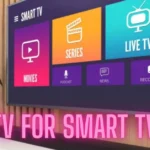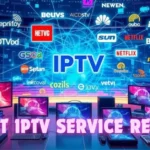
What is IPTV?
IPTV (France IPTV)stands for Internet Protocol Television. An Internet Protocol (IP) network delivers television content instead of traditional satellite or cable television formats. It is capable of offering both on-demand and live content.
France IPTV enables users to stream various types of media content. Including live TV channels, films, and videos, with the only requirement being an active Internet connection.
IPTV is a system that delivers digital television services to subscribers via Internet protocol technology. Viewers can watch their favourite shows on a variety of devices. Including TVs, computers, smartphones, and tablets, using IPTV-compatible apps or software.
You can start your streaming service with just one click. IT personnel or coding knowledge will not be required for the instant deployment of all solutions.
It differs from VoD streaming programs like Netflix, though.
However, there are also some similarities between IPTV and traditional TV. For example, unlike traditional TV. Multiple TV sets in a home can use a single subscription for IPTV. Viewers can also choose the show they want to watch whenever and wherever they want with IPTV. Which is a convenient extra feature. IPTV subscribers can watch previously aired content in addition to live TV shows that are currently airing.
How is IPTV different from Traditional TV?
Let’s compare the traditional way of watching TV with IPTV in order to better understand how the two are different.
IPTV vs. Traditional TV
Traditional TV (Cable and Satellite TV) IPTV
Both cable and satellite work by allowing viewers to access particular channels through the signal. The main distinction lies in the fact that cable uses a connected wire. While satellite operates without wires (at least until it reaches your home). IPTV utilizes an IP-based network to transmit TV channels to users’ set-top boxes. Internet networks are distinct from cable and satellite networks. Because they provide content using the client-server model that is also used for email, websites, and other online services.
An excellent illustration of Cable TV is Time Warner Cable, sent through a coaxial cable connection. While an instance of Satellite TV comes from providers such as DirecTV, sent to viewers via radio waves. As discussed later in this blog, IP. Also known as Internet Protocol, is the communication method used to transfer data packets between computers connected to the internet. In IPTV viewers ask for TV shows . And receive video content through Internet Protocol (IP) networks rather than cable or satellite delivery.
Cable or satellite services broadcast content instantly, utilizing a transmit-and-forget approach. The IPTV server can save the shows on servers located at the source. Enabling users to access the content online whenever they want.
How Does IPTV Work?
IPTV resembles surfing the Internet more than it does traditional channel flipping. It simply relies on IP (Internet Protocol). A transport protocol that serves as the means to send the videos to the viewer.
The selection of a TV program or video by the viewer results in the splitting of data into packets. Which are then sent from multiple servers over the Internet.
Video servers deliver programs to homes using fiber-optic cables and internet connections, sending out requests and receiving shows in return.
Let’s examine the IPTV structure to gain a deeper understanding of how France IPTV functions.
IPTV Architecture
Two primary types of IPTV architecture can be chosen for deployment based on the network architecture of the service provider. Centralized and distributed.
The centralized architecture model is a solution that is relatively straightforward and simple to manage. Since all media content is saved on centralized servers, there is no need for an extensive content distribution system.
Centralized architecture works well for networks with limited VOD service deployment, sufficient core and edge bandwidth, and an effective CDN.
Distributed architecture can scale just as efficiently as the centralized model. Nevertheless, it offers benefits in terms of bandwidth usage. And includes important system management features necessary for overseeing a larger server network.
Operators who intend to implement a somewhat large system should, consequently. Think about incorporating a distributed architecture model from the beginning. Intelligent and sophisticated content distribution technologies. Are needed for distributed architecture to enhance the efficient delivery of multimedia content across the service provider’s network.
Architecture Diagram of a Typical France IPTV Network
The central unit receives broadcast content from Satellites and Local Antennas. The main unit is where live TV channels and AV sources are encoded, encrypted, and distributed as IP multicast streams.
The Advertising Servers, Live TV Streaming Servers. And Video on Demand (VOD) servers & platform will also be housed in the Central unit. Which stores and serves on-demand video assets as IP unicast streams upon user request. The VOD platform can be situated inside and seen as an integral part of the IPTV’s main system.
The viewer receives the requested videos and TV Channels through a delivery network. That includes a strong internet connection through Fiber Optics from the IPTV broadcaster’s end.
The signal will be delivered to the viewer through their chosen internet service provider. Which may include options such as broadband, fiber optics, DSL, etc..
How Does IPTV Work From the Viewer’s End?
Upon subscribing to a specific IPTV service, the viewer will receive the service’s designated Set Top Box (STB).
An endpoint device called a set-top box (STB) decodes and decrypts TV. And VOD streams to be displayed on a TV screen. This set-top box is linked to the viewer’s internet connection (router) and utilizes the internet to send video. And TV content to the viewer.
Via an interactive portal within the STB. The viewer can request videos or TV channels and navigate between various IPTV services including the VOD catalog.
Although this IPTV architecture model is common. Various service providers in the current market have the flexibility to implement a slightly unique architecture. That aligns with their specific requirements, geographical location, internet connectivity at endpoints, local market conditions, and business model.
Nevertheless, the fundamental principles remain consistent and may resemble what is shown here.
What is an IPTV Box?
An IPTV Box is a type of set-top box that is capable of converting Internet protocol signals into a format. That is comprehensible and functional for your television. This is significant since your television lacks a built-in system to analyse signals received over the Internet. As a result, these IPTV Boxes play an important role in this process by serving. As a link between your TV and the Internet.
They connect to your television via HDMI or AV cables. In recent years, certain IPTV devices have been able to connect to WiFi. So, if you have a smart or connected TV that connects over wifi. You won’t need anything more to talk with your IPTV box.
So, what if you don’t want to get an IPTV box? You can still stream IPTV material from your PC. Because designers have already created PCs to detect and analyze internet signals. You may use them to watch IPTV content and, if desired, screencast the content on your PC to your TV.
Types of IPTV Formats & Services
Apart from transmitting classic TV channels, IPTV has many additional formats, therefore it provides a variety of IPTV services. France IPTV also provides the interactive services listed below.
IPTV services include video on demand, near video on demand, and time-shifted TV. Video on demand allows subscribers to watch films from the server’s media library. While near video on demand is a pay-per-view service for multiple users. Subscribers can view the broadcasting schedule and watch content based on their interests.
Devices That Work With France IPTV Services
The particular name or type of gadget that will operate may vary based on the IPTV provider you are using. However, France IPTV services are generally compatible with a vast number of devices, such as:
- Android smartphones and televisions
- iPhones, iPads, and MAC computers
- Tizen TV by Samsung
- LG webOS (LG TV and other devices)
- Amazon Fire OS-powered devices and TVs
So, if you utilise any of these, rest confident that 99 percent of IPTV providers will operate with them.
What Are The Pros and Cons of France IPTV?
Every system has advantages and disadvantages, and France IPTV is no exception. It has several advantages for users; let’s look at a few of them first.
Pros of France IPTV:
IPTV viewers can enjoy considerably more flexible TV viewing by pausing, rewinding, and fast-forwarding the content at their leisure.
Most IPTV boxes enable HD and 4K streaming, so you’ll get considerably better visual quality than with a regular TV.
Some IPTV boxes include channels and apps tailored to certain niches. As a result, you will be able to stream a variety of stuff and have more possibilities.
Cons of France IPTV:
It requires a high-speed internet connection, therefore folks in distant locations. Who do not have access to high-speed wifi will be unable to utilise it effectively. A number of reasons, including network issues and device incompatibilities, can cause IPTV to lag and experience outages.
In short, IPTV works best in places with high internet connectivity. So, if you have a reliable internet connection. And an HDMI-enabled TV that can connect to WiFi (if necessary) go for it.
Market Size and Future of IPTV
IPTV has grown steadily in recent years. Experts anticipate that the global IPTV market, estimated to be worth $50.9 billion in 2021, will grow to $115.2 billion by 2026. As a result, analysts expect the IPTV market to develop at a CAGR of 17.8% throughout this period.
North America will be the largest market for IPTV in the future years. Asia is not far behind, with China and India driving great growth in this region.
Many factors contributed to the expansion of IPTV, including global increases in internet penetration and speed. They received significant boosts in specific regions, such as China. As a result, China had approximately 179.7 France IPTV users by the end of 2022. India has approximately 68.1 million customers by the end of 2022.
IPTV’s market share improvements will mostly come at the expense of cable, with satellite holding up nicely. Indeed, satellite platforms benefit from IPTV growth by feeding channels to head ends for distribution via the terrestrial fixed broadband infrastructure.
According to Reddit’s list of global IPTV providers. IPTV networks are accessible in the United States, Russia, the United Kingdom, Canada, France, Belgium, India, Germany, China, Sweden. And even the Dominican Republic.
Even though there are international companies offering IPTV services that are fostering its expansion. We are witnessing a change in IPTV consumption and anticipate that. As a trend, watching habits will increasingly shift to OTT and SVOD services like Netflix and Hulu.
Is France IPTV Subscription Legal in the France ?
IPTV subscriptions, and IPTV services in general. Are legal as long as the France IPTV service provider obtains the necessary licenses to stream the material. We are aware that someone holds the copyright for all information. And if the IPTV service provider streams the episodes without the proper consent from the copyright holders. It will be clearly illegal.
However, if you utilise an IPTV provider. Then use video streaming platforms such as Netflix and Amazon Prime Video to watch your material, this is all legal. Because these streaming sites control the copyright to their content. Also, many IPTV service providers have a license to stream specific content, which is lawful!
Wrapping Up
We hope this explanation of what IPTV is and how it operates has been helpful. Furthermore, if you want to launch your own streaming business, we have the ideal answer!
Muvi One offers an end-to-end solution that includes everything you need to start your own over-the-top streaming service.
- Computer Infrastructure,
- CDN,
- Platform for Online Videos,
- DRM,
- Participant,
- CMS,
- Options for monetisation,
Integration of payment gateways with front-end platforms, such as websites and mobile and TV applications.
With just one click, your streaming service can be started. And all solutions will be instantly deployed without the need for IT personnel or coding knowledge. To begin using your own Multi-Screen OTT Service right now, click this link!





